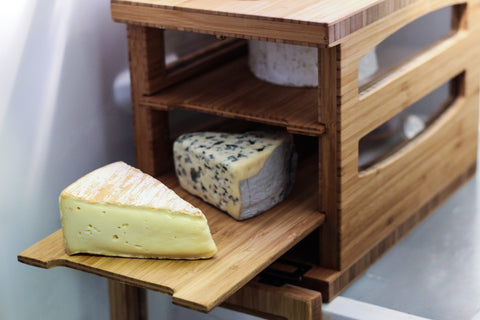
Naturally-made cheese is a complex food. I designed the Grotto as a tool for becoming more acquainted with that wonderful complexity. As a cheese ripens, it develops different flavors, aromas, and textures dependent upon the storage conditions. The art of cheese preservation has no hard and fast rules, but it does have guidelines. Those guidelines provide a road map for your journey with specialty cheeses. I am starting to share more specifics about cheeses and their preferred storage methods, something beyond the basics. For example: many styles fall under the Bloomy Rind category, but they do have varying characteristics and textures depending on the specific cheese that are best enjoyed within certain windows of time, even if they can be held for longer. I do suggest you to invest in an inexpensive hygrometer/thermometer if you'd like to go deeper into the world of cheese preservation. This is Part 1 of a somewhat endless series, due to the endless varieties of artisan cheese. Enjoy!

Hervé Mons Camembert
This pasteurized cow milk Camembert is ripened to a round, unctuous texture and is amazingly consistent and resilient. Because the Camembert is a higher moisture style, it fairs well in cooler climates with a higher humidity This is a style, then, that I would chose to store in the fridge or a cooler wine cellar if I am looking to preserve it for months. Otherwise, I have stored the Camembert at room temperature (65 degrees, approx) to allow it ripen over a few days to two weeks (depending on the stage of ripeness) to serve. If the cheese is on the younger side, it will be firmer and more dense, and will need the extra time to ripen (up to two weeks). If the cheese is on the older side, it may only need one to two days to ripen to perfection. This is a fun trick that I do to get a cheese to bloom to a perfect flavor and texture before I serve it.

St. Nectaire
St. Nectaire is a beautiful washed rind semi-soft cheese from the Auvergne-Rhône-Alpes, France. The version that is widely available in the states is pasteurized, and is often shipped on the younger side to distributors so that it has a long shelf life on the supermarket shelf. The paste should be spreadable at room temperature, but if it is not, you can ripen it for longer in the Grotto to soften it up. One important note: cheese wheels that have been cut will no longer ripen as beautifully as cheese wheels that are left intact. It is similar to when a bottle of wine is opened, although cheese lasts months longer than a wine bottle when opened. But my trick is to again leave the cut St. Nectaire in a warmer environment (55 to 65 degrees F) for a day to three days and it will surely soften and become more spreadable. When a cheese's rind is washed in brine, the rind will always have a slightly sticky quality to it. The art of this preservation is to maintain the humidity level (listed above) without allowing it to become overly damp.

Pleasant Ridge Reserve from Uplands Cheese
This cheese, modeled after Beaufort is smooth in texture, with tiny amino acid crystals dotting the paste. The rind is firm, smooth, and natural, meaning the cheese has been brushed and washed occasionally in the cave's open air. This category of cheese is semi-firm, meaning it is not as dense as Pecorino Romano or Parmiggiano Reggiano, but it never gets unctuous like a St. Nectaire. This style can fare well for longer periods of time in slightly warmer than refrigeration temperatures, as long as the humidity stays within range. If this cheese dries out on its surface, it will become somewhat gummy in texture.

Hook's 10-year Cheddar
When I tasted this cheddar, aged ten years, I was absolutely surprised by its youthful creamy texture and dense protein crystals. This is because the cheddar is wrapped in plastic during the aging process, trapping the moisture in and keeping the oxygen out. It is absolutely fascinating the difference it makes to ages a cheese anaerobically (no oxygen) versus aerobically (exposed to oxygen). The flavor and texture would be dramatically different. This cheese is best stored in cave-like conditions due to its butterfat content, which may seep out at warmer temperatures. If stored properly, it could last you up to another 6 months!
Landmark Creamery's Pecora Nocciola
This cheese is mild, salty, and grassy with a denser and drier texture and hints of brown butter. Dense sheep milk pecorino styles are inclined to seep a little butterfat is well, which is why the recommended storage temperature is slightly cooler than other styles of dense cheese. This is something to keep note of when storing denser styles.

Bleu D'Auvergne
I've written a lot about this cheese in the last few weeks, so it may be apparent that I love it. This is a high moisture, creamy style of blue that does best when stored in the fridge or only slightly warmer. It also loves a high humidity environment because of its delicate, creamy paste. However, if Blue D'Auvergne is stored in slightly less humid conditions (such as 68%), it won't go bad, it'll simply get denser and more crumbly in texture. An overly damp blue is not as desirable as a slightly drier blue.
As seen in the photo below, the blue cheese is stored on the same shelf as the washed rind St. Nectaire, with an ample inch of space in between the styles. This is because these two styles are more pungent than other styles, and give off more an aroma. In that regard, they do better when stored away from the milder styles.

Photos by Jess Hitt



1 comment
Do you have Beer cheese
Leave a comment